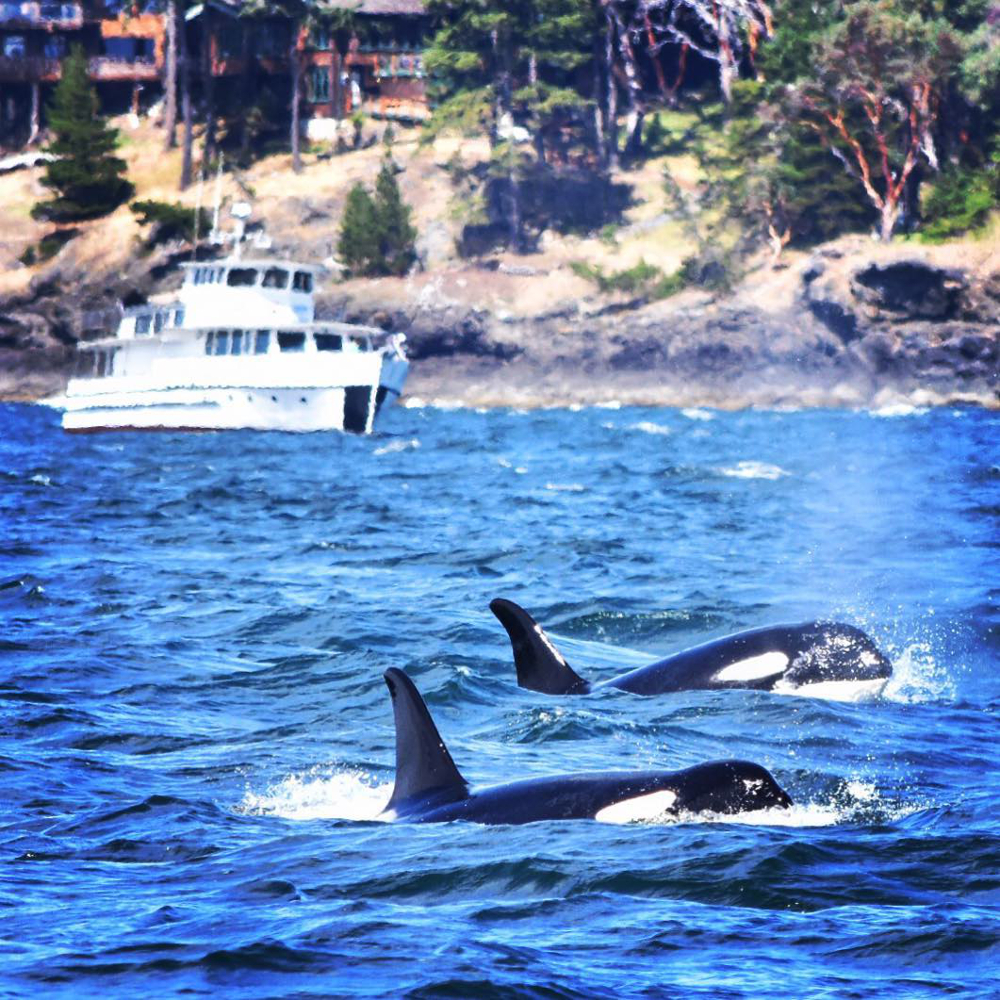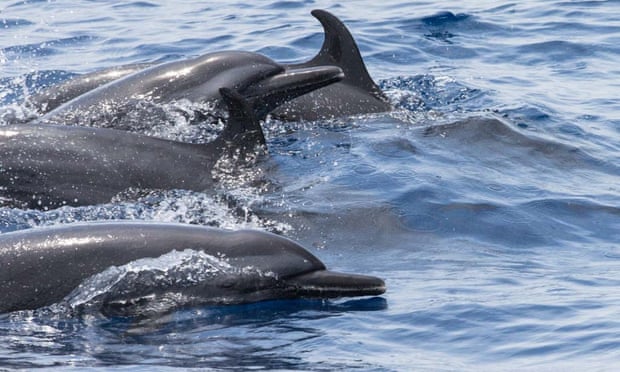More NRKWs, Breaching Humpbacks, Bigg’s and More
Some more of the Northern Resident Orca population have made their way into the top of Johnstone Strait They still have not ventured very far down the Strait. While the Southern Resident pods are staying well to the south in Puget Sound where J50 the three year old emaciated female was giving antibiotics to hopefully help her survive.
Transient Bigg’s have been seen passing through both north and southbound on the hunt, while Humpback Whales are still breaching everywhere, but appear to have spread out a bit farther in smaller gatherings.
Pacific White Sided Dolphins also have been on the move in numbers, with both Dall’s and Harbour Porpoise seen in slightly larger groups mostly through inside waters.
There are still many near misses with boaters almost striking whales. Slow Down Please! And spread the word.
Keep your eyes open, report your sightings to us, and use caution on the water giving these animals plenty of room. Stop and smell the fish breath.
We appreciate and thank you for your kind donations. Donations Page
Our Cetacean Web Camera YouTube Channel is live. We’re continueing to work on resolving transmission problems causing the intermittent bouncy images from the Beach Gardens Marina camera. Our second (backup) live stream mounted in Powell River appears when the Beach Gardens camera is down. We appreciate your patience.
Our team of online Volunteers continue to do a great job in making sure all your sightings reports are mapped and published regularly. Would you like to join us?
Review our current Volunteer Job Postings
Archive Explorer navigates 10,000+ Cetacean Sightings, images, videos and audio recordings.
*Recommended for desktop browsers and newer mobile devices
Archive Explorer dives into the Coastal Cetacean world. View Cetacean sighting locations, photos and videos:
- All species including Orca, Humpback, Grey Whale or Dalls Porpoise
- Follow the endangered Southern Residents Orca in the Salish Sea
- Search for encounters with T002C2 Tumbo
- Witness a close-up Orca encounter video in Port Alberni harbour
- Follow the T010s Transients as they hunt and travel the inside passage
- Track “KC”, the ever popular Humphack’s movements this past August
- Locate any of 12,000 named locations on the BC and WA State coast
- Print custom sighting reports and maps (Coming Soon)
Archive Explorer Help Page explains many advanced functions
Send your Comments and Questions to: Archive Explorer Feedback
Sightings Open Data includes all sightings data, photos and videos, in a table you can filter and download.
Southern Vancouver Island is home to a thriving whale watching industry, loved by tourists, but often maligned by locals. The industry grew around watching the residents due to their once predictable summer appearance.
However since 2013 there has been a marked change. The transient population, once rare and elusive, are now thriving and frequently seen in the Salish Sea. The arrival of the residents is now unpredictable, their numbers declining. The contrast is stark and the cause obvious – residents rely on the Chinook, now scarce, transients feed on seals, now abundant.
When I started whale watching in 2003 as a captain and naturalist it was fun and easy. Sure there were days when we didn’t find whales, but not many. Most days were the same: fill up your boat with passengers, drive over to San Juan Island to observe the residents feeding, drive home and repeat….
read on
Department of Fisheries and Oceans officials say the transient killer whale known as T73B immediately responded to the recorded sounds of whales likely familiar to him and left the harbour and was last seen heading for open ocean.
‘Really odd’ killer whale draws a crowd in Comox Harbour
DFO spokesman Paul Cottrell says the lone whale has been a frequent visitor to the busy harbour in Comox on Vancouver Island for several days and concerns were increasing for its safety and members of the boating public….
read on
“Progress!” NOAA Fisheries declared in a tweet. “Response teams reached J Pod today in Canadian waters & followed them into U.S. waters near San Juan Isl. While very skinny & small, J50 kept up with her mother & siblings. Veterinarian Marty Haulena from the Vancouver Aquarium got a thorough look at her.
“The team obtained a breath sample to help assess infection & and gave antibiotics. Next step is to determine whether to proceed w/ trial feeding, depending on conditions & location of the whales. Great work by the teams on the water!”
The National Oceanic and Atmospheric Administration (NOAA), along with Fisheries and Oceans Canada, have the authority to administer antibiotics to the sick and starving 3-year-old orca known as J50.
J50 was last spotted Wednesday alongside her mother. The J Pod was seen earlier Thursday, but neither J50 nor J35, the orca carrying her dead calf, were immediately seen…
read on
She shot a video that has been viewed more than 1.5 million times on Instagram and shows the whales leaping from the water mere metres from the tourists.
Leehane says the video shows the whales using a feeding technique called bubble netting, in which humpbacks blow a large circle of bubbles around fish to trap them.
She says she’s never seen whales so close to the lodge, and until last year she’d never seen humpbacks in the area use the bubble-netting technique to catch fish.
The technique is learned, rather than instinctual, and not all groups of humpbacks know how to do it, so seeing it up close was a special experience for Leehane.
"One of them will swim in a circle around fish, and as it’s doing it, it will release air from its blowhole, and basically create a net of bubbles," she says.
"Then the fish get more and more concentrated … so (the whales) will get a lot more of them in each mouthful."…
read on
The 20-year-old orca, known as J35 or Tahlequah, gave birth to a female calf on July 24. The baby orca died only a few minutes later. Keeping the calf’s lifeless body afloat atop her head, Tahlequah has been swimming through choppy seas for more than 10 days, as of August 2, the pair’s last known sighting:
The pair’s journey has been described by observers and orca researchers as a "tour of grief." That’s because the obvious bond between mother and child orca-what’s known as "nurturant behavior" towards a dead calf-reminds us of our own human mother-child instincts. To see J35 grieving her dead child is to imagine ourselves going through the same process; hence the global outpouring of empathy for the whale. And on a fundamental level, the orca’s evident bond with her child reminds us of how much we have in common with other animals.
As Susan Casey, an author who has written several books about ocean life, writes in The New York Times, "To learn the orcas’ natural and cultural history is to understand how closely connected a mother and calf are, how tight-knit their bond."…
read on
LADbible, UK
“The two species interacted for about 45 minutes. It appeared that the dolphins would swim between the solo whale and the mother and calf that were located about 100m away.
“The whales are Southern Right Whales. They migrate from Antarctica to the Southern half of Australia between the months of June and October each year. They do so to rear their young in our calmer waters.”…
read on
There are 90 distinct species of cetacean – and at least 30 of them occur in Timor-Leste. These include both local populations like melon-headed whales and spinner dolphins, and migratory species such as humpbacks and pygmy blue whales. Managed properly, whale tourism could generate significant income for Timor-Leste, one of the world’s youngest – and poorest – nations.
But the local whale population faces a number of threats. Timor-Leste is seeking to establish itself both politically and economically following a decades-long conflict with its former coloniser Indonesia, which only came to an end in 2002. Illegal fishing from neighbouring countries is rife and the tiny nation doesn’t yet have the resources to prevent it. Besides a single patrol boat there is no monitoring system to identify shipping in its territorial waters. Whales are getting tangled in vast ghost nets that drift all the way down to the Australian coast. According to Andrews, these intruders aren’t just artisanal fishers, but entire fishing fleets….
read on
When National Geographic caught up with Pyenson in Washington D.C., where he is Curator of Fossil Marine Mammals at the Smithsonian Institution, he explained how one ancient species of whale looked more like a dog than a marine creature, what he discovered when he spent time on an Icelandic whaling vessel, and how climate change is creating both winners and losers for whales.
Say whale and we think of a giant, oceanic creature. But the earliest whales, I was amazed to discover, were land-dwelling creatures the size of a German Shepherd. Tell us about Pakicetus and how it turned into a present-day whale….
read on
read on
Strandings data from the Museum also shows that more whales and dolphins are washing up along the UK coastline, possibly suggesting more animals are paying the country a visit.
Dr Chiara Giulia Bertulli, organiser of this year’s national event, reported that 527 sightings were submitted after the nine-day count. Species numbers are up 50% on last year….
read on








